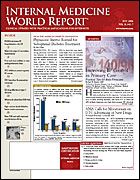Publication
Article
Internal Medicine World Report
Inhaled Corticosteroids Increase Fracture Risk
Author(s):
From The American Thoracic Society
SAN DIEGO—New findings released at the American Thoracic Society 2006 International Conference bolster evidence that inhaled corticosteroids are an independent risk factor for fracture.
Richard B. Hubbard, MD, professor of respiratory medicine at the University of Nottingham, United Kingdom, and colleagues studied the dose-response relationship between inhaled corticosteroid exposure and time to first fracture.
Results showed that the use of inhaled corticosteroids is associated with a dose-dependent increase in fracture risk. “The data thus suggest that inhaled corticosteroids may have a direct adverse impact on bone,” he said.
Although earlier studies have described an association between the use of inhaled corticosteroids and fracture, it has not been determined to what degree this association is a function of inhaled corticosteroid use or of other factors, such as the severity of airflow obstruction, Dr Hubbard pointed out. For example, some researchers have reported that the use of inhaled corticosteroids in patients with chronic obstructive pulmonary disease (COPD) decreased bone mineral density (BMD), whereas others have suggested that these inhaled medications have a neutral effect on BMD.
Furthermore, epidemiologic studies have suggested an association between inhaled corticosteroids and fracture risk, he said. However, the epidemiologic studies have been limited by a short duration of follow-up and a lack of information on potentially important confounders, such as physical activity or socioeconomic status.
In contrast, this new study included 1671 participants who had been diagnosed with asthma or COPD (mean age, 80.6 years), and the mean total duration of follow-up was 9.4 years. Overall, 982 (59%) patients had received ≥1 prescriptions for an inhaled corticosteroid at a median daily dose of 219 µg.
P
During the follow-up period, 187 patients sustained a fracture. After adjusting for age and gender, there was a significant dose-related increase in fracture risk with exposure to inhaled corticosteroids. Patients who had a mean daily dose >601 µg had a 2.53-fold increased risk of fracture ( <.001).
The results were similar after adjusting for oral corticosteroid exposure, airflow obstruction diagnosis, a history of fracture, and bronchodilator use.
“Although inhaled corticosteroids are effective for the treatment of airflow obstruction, particularly asthma, our study shows that patients with asthma or COPD should be advised to use the lowest effective dose to control their airflow obstruction,” said Dr Hubbard.
KEY POINTS
Inhaled corticosteroids are an effective treatment for airflow obstruction, particularly asthma.
Long-term data reveal a significant link between these agents and risk of fracture.





